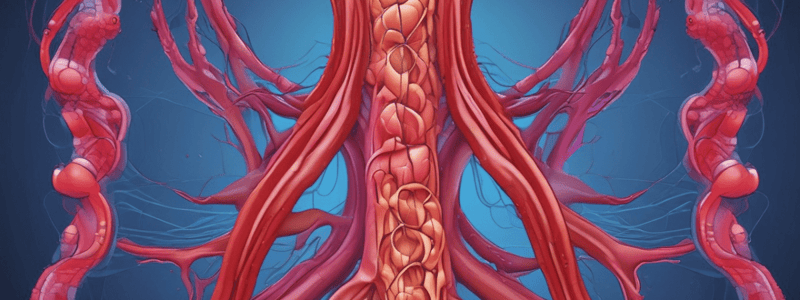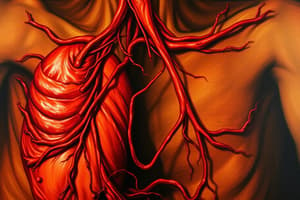Podcast
Questions and Answers
What is the gross appearance of the liver in right heart failure due to central venous congestion?
What is the gross appearance of the liver in right heart failure due to central venous congestion?
- Uniformly pale with slight swelling
- Pale with a smooth surface
- Dark and firm
- Red-brown and yellow mottled (correct)
What term describes the accumulation of fluid in the peritoneal cavity?
What term describes the accumulation of fluid in the peritoneal cavity?
- Hydropericardium
- Edema
- Ascites (correct)
- Hydrothorax
Which component is NOT part of Virchow's Triad, which predisposes individuals to thrombosis?
Which component is NOT part of Virchow's Triad, which predisposes individuals to thrombosis?
- Endothelial injury
- Hypercoagulability of blood
- Increased coagulation inhibitors (correct)
- Alteration in blood flow
What type of edema does not produce a depression upon pressure application?
What type of edema does not produce a depression upon pressure application?
What is the characteristic feature of 'Brown induration of the lungs' seen in left heart failure?
What is the characteristic feature of 'Brown induration of the lungs' seen in left heart failure?
In the context of edema, what happens due to increased capillary permeability?
In the context of edema, what happens due to increased capillary permeability?
What defines a mural thrombus?
What defines a mural thrombus?
What condition is characterized by the organization of hemorrhages with deposits of iron and calcium on fibrous connective tissue?
What condition is characterized by the organization of hemorrhages with deposits of iron and calcium on fibrous connective tissue?
Which of the following is a common site for thrombosis in veins?
Which of the following is a common site for thrombosis in veins?
What causes the heavy, firm consistency of the lungs in left heart failure?
What causes the heavy, firm consistency of the lungs in left heart failure?
What process refers to the enlargement of a thrombus by additional platelets and fibrin?
What process refers to the enlargement of a thrombus by additional platelets and fibrin?
Which type of emboli is characterized by a mass that is detached from its site of origin?
Which type of emboli is characterized by a mass that is detached from its site of origin?
What is the most common and fatal form of venous thromboembolism?
What is the most common and fatal form of venous thromboembolism?
Which complication of pulmonary thromboembolism is characterized by sudden death?
Which complication of pulmonary thromboembolism is characterized by sudden death?
What term describes the localized area of tissue necrosis due to occlusion?
What term describes the localized area of tissue necrosis due to occlusion?
Which type of emboli travels from venous to arterial circulation bypassing the lungs?
Which type of emboli travels from venous to arterial circulation bypassing the lungs?
What is a common origin for systemic thromboemboli?
What is a common origin for systemic thromboemboli?
Which factor is NOT a consequence of pulmonary thromboembolism?
Which factor is NOT a consequence of pulmonary thromboembolism?
What type of emboli can include fat globules or amniotic fluid?
What type of emboli can include fat globules or amniotic fluid?
What is commonly observed as a source of thrombi contributing to pulmonary embolism?
What is commonly observed as a source of thrombi contributing to pulmonary embolism?
Which of the following accurately describes hyperemia?
Which of the following accurately describes hyperemia?
What is the primary difference between hyperemia and congestion?
What is the primary difference between hyperemia and congestion?
Which of the following represents a cause of congestion?
Which of the following represents a cause of congestion?
What does edema refer to?
What does edema refer to?
Which of the following options is NOT a component of Virchow’s triad?
Which of the following options is NOT a component of Virchow’s triad?
What defines thrombosis?
What defines thrombosis?
Which type of infarction is typically characterized by a well-defined area of necrosis?
Which type of infarction is typically characterized by a well-defined area of necrosis?
What is a common fate of arterial thrombi?
What is a common fate of arterial thrombi?
Embolism can occur due to various factors. Which of the following is a type of embolism?
Embolism can occur due to various factors. Which of the following is a type of embolism?
Which mechanism is primarily responsible for the formation of edema?
Which mechanism is primarily responsible for the formation of edema?
Flashcards are hidden until you start studying
Study Notes
Hemodynamic Disorders
- Include hyperemia, congestion, hemorrhage, edema, thrombosis, embolism, and infarction.
Hyperemia and Congestion
- Hyperemia: Active process with increased blood flow due to arterial dilatation; example: skeletal muscle post-exercise, blushing.
- Congestion: Passive process from impaired venous outflow; acute congestion leads to blue-red coloration (cyanosis).
- Causes of congestion: portal vein obstruction in liver cirrhosis, external vessel pressure, or thrombosis.
Morphology of Congestive Venous Congestion (CVC)
- Lung: Heavy, dark brown (“Brown induration”), capillary rupture, and intra-alveolar hemorrhages lead to heart failure cells.
- Liver: Enlarged with a nutmeg appearance due to alternating red and yellow mottling from congestion and fatty changes.
- Spleen: Congested with a tense capsule, gray-tan cut surface seen on microscopy with Gamna Gandy bodies.
Edema
- Defined as abnormal fluid accumulation in interstitial spaces; types include ascites, hydrothorax, and hydropericardium.
- Pathogenesis involves increased hydrostatic pressure, decreased plasma oncotic pressure, lymphatic obstruction, sodium retention, increased capillary permeability, and tissue factors.
- Common sites: subcutaneous tissues, lungs, and brain; categorized into pitting (e.g., subcutaneous edema) and non-pitting (e.g., myxedema).
Hemostasis, Thrombosis, and Embolism
- Normal hemostasis requires integrity of blood vessels, adequate platelets, and coagulation factors/inhibitors.
- Thrombosis: Formation of a blood clot (thrombus); Virchow’s triad includes endothelial injury, abnormal blood flow, and hypercoagulability.
- Thrombi can form in various sites: heart, arteries, and veins with varied morphology and attachment patterns.
Fates of Venous Thrombi
- Can propagate, resolve, embolize, or undergo organization and recanalization.
- Thrombi obstruct vessels and may lead to thromboemboli.
Embolism
- Defined as obstruction caused by a mass in circulation; most are thromboemboli.
- Types include solid, liquid, and gas emboli; also classified by source (cardiac, arterial, venous).
- Pulmonary Thromboembolism: Most common and fatal; originates from deep veins and can cause “saddle embolus”.
Consequences of Pulmonary Thromboembolism
- Varies based on vessel size, number of emboli, and patient cardiovascular status.
- Potential outcomes include sudden death, acute right heart failure, pulmonary infarction, and hemorrhage.
Systemic Thromboembolism
- Emboli that travel within arterial circulation, originating from diseased heart conditions.
- Can cause infarction in various organs, including the brain, kidneys, and limbs.
Infarction
- Ischemic necrosis due to arterial or venous blockage; results in localized area of necrosis (infarct).
- Most infarcts are due to thrombotic or embolic occlusion; etiologies include cardiac insufficiency, arterial obstruction, and microcirculation issues.
- Types of infarcts based on color (red or white), infection status (septic or bland), and age (fresh or old).
Types of Infarcts
- Red (Hemorrhagic): Occurs in tissues with dual blood supply or venous occlusion.
- White (Anemic): Seen in solid organs with end-artery supply; wedge-shaped appearance in heart, spleen, kidney.
Studying That Suits You
Use AI to generate personalized quizzes and flashcards to suit your learning preferences.




